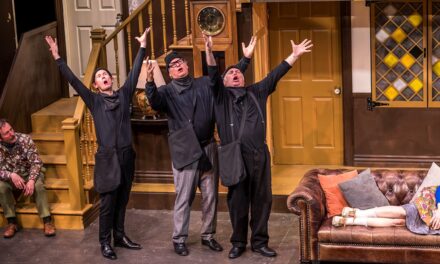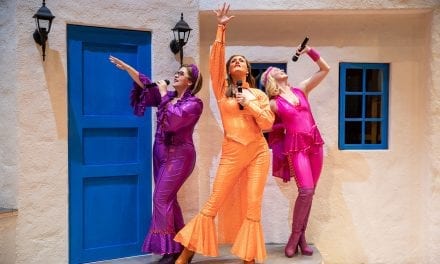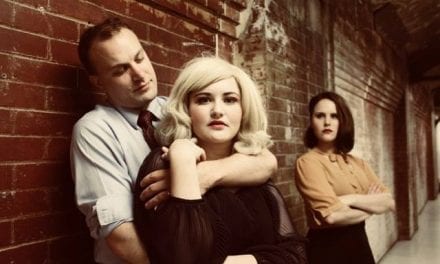OREM —Heroes are often known for their choices between good and evil, light and darkness. Whether it’s the fiery depths of Mordor or a hungry wolf hanging out in grandma’s bed, it is generally clear which dangers to avoid. But Mark Twain’s Huckleberry Finn was brought up in a time and place that taught him a misguided sense of right and wrong. He keeps having temptations to do things another way, but without a clear sense of principles, Huck has to struggle through the muddy waters of morality. This story, brought to the stage by Roger Miller and William Hauptman as the musical Big River, explores prejudice and cruelty through the eyes of a youth. And Hale Center Theater Orem allows us to ride along.
Big River is a musical with a great deal of sincerity. So many of the tender moments are thanks to the wonderful songs by Roger Miller. Orem’s Hale has filled these ballads with talented musicians and singers. I was delighted to have seen this production, and the creative touches infused therein. Director Christopher Clark and music director Justin Bills won my absolute respect by moving their musicians out of the dark and into the show. Each orchestra member wore a costume and was visible on set with their instruments; each also played a role (or multiple roles) in the story. The orchestra became observers, also; one guitar player was parked on a staircase for several scenes, and Huck jumped right over him like a piece of furniture. The musicians seemed well rehearsed and I was impressed with their tone. However, I would have liked to hear the fiddle better—perhaps the microphone wasn’t as strong as the others. There was also one actor-becomes-musician transition that felt awkward: the judge (Bryan Matthew Hague) finished his lines as his guitar strap was placed over him, and the moment didn’t sit right within the scene.
This cast was consistently talented, and even I am surprised that I have nothing to critique about their performances. Clear singing voices and committed, enthusiastic acting permeated the theater. With so much to enjoy, I will keep my praise limited to the absolute highlights. The first of which was Daniel Fenton Anderson’s performance of “Guv’ment,” which just lit up the theater. Anderson was completely transformed into the weathered, gruff Pap (father of Huckleberry Finn). He spat out the lyrics and jumped his way around the stage; it was a wonder. Another favorite of mine was the solos of Melanie McKay Cartwright (as Mary Jane) and Mackenzie Seiler (as Slave/Alice). Both ladies sang with poignancy, Seiler in “The Crossing” and Cartwright in “You Oughta be Here With Me.” I was touched by their voices and glued to their performances. The last musical acknowledgment I cannot omit is to the partnership of Jim and Huck. Conlon Bonner and Andrew Robertson were such a pleasant duo; they had a natural camaraderie, and their voices elevated the already beautiful melodies. There were moments in “Muddy Water” and “River in the Rain” when I held my breath a little, just reveling in the comfort, warmth, even magic of that combination.
Standouts in the acting arena included mostly comedians. I was delighted by Hannah Gassaway’s eccentric Miss Watson, and her over-the-top sewing lady. There were some terrific accents, also. In Bricktown, Arkansas, three men dozed on stage; one of them spoke out of the side of his mouth, like he was chewing tobacco, and I was fascinated by the way he spoke. The King (Steve Dunford) and the Duke (Jacob Theo Squire) were equally entertaining, bursting with misplaced enthusiasm. Jason Sullivan really sold Tom Sawyer’s enthusiasm for complicated adventures; Sullivan had a good handle on comedic timing. Bonner and Robertson, as the leads, fit their individual characters in every respect. Bonner spoke with conviction about his displaced family, which touched me, and Robertson easily conveyed the youth of his character, and the mess we often make of simple things.
Reluctantly, I have to say I was let down by the shortage of men in Tom Sawyer’s cave, and the absence of black actors in the ensemble. To fill in these casting holes would have added authenticity and strength. The colors used in the set were fitting, and I liked the trees, wood, and crates in Bobby Swenson‘s scenic design). The “raft” required some imagination from the audience; I tried very hard not to miss the river I’d experienced at West Valley Hale, years ago (which was tough to do). I’m glad that Orem did, at least, have rain, and very realistic river sounds from the cast. Maryann Hill’s costumes were well crafted and interesting to see; I was most struck by the dressed up Duke and King, and the fabric of Jim’s pants. But when a mob gathered, wearing potato sacks (or something similar) on their heads, I just cringed and thought of Batman Begins.
This already rich musical was truly illuminated by the talent of Hale’s cast. I was admittedly surprised to find such quality, having never been to this theater. I’m so glad to say that Hale Center Theater Orem exceeded my expectations and reminded me why I love Big River.








